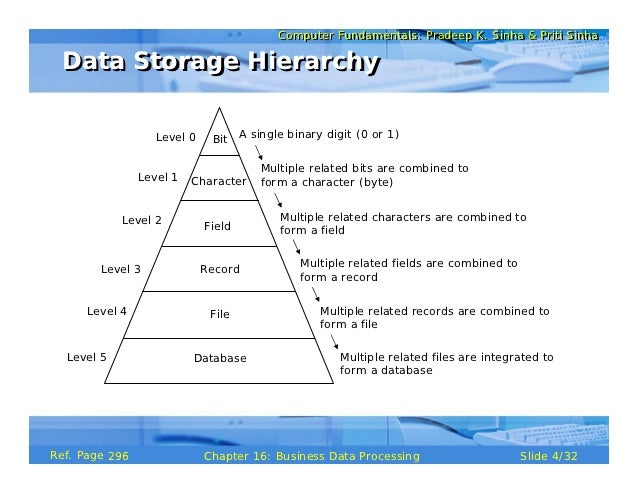Database
- Collection of data organized in a manner that allows access, retrieval, and use of that data.
Data
- Collection of unprocessed item.
Examples
- Text
- Numbers
- Images
- Audio
- Video
Information
- Processed data
- Documents
- Audio
- Video
- Images
Valuable Information should have the following;
- Accurate
- Verifiable
- Timely
- Organized
- Accessible
- USeful
- Cost effective
Hierarchy of Data
- Bit
- Character
- Field
- Record
- File
- Database

Database Design Guideline
Database design is the process of producing a detailed data model of database. This data model contains all the needed logical and physical design choices and physical storage parameters needed to generate a design in a data definition language, which can then be used to create a database. A fully attributed data model contains detailed attributes for each entity.
- Determine the purpose of the database - This helps prepare for the remaining steps.
- Find and organize the information required - Gather all of the types of information to record in the database, such as product name and order number.
- Divide the information into tables - Divide information items into major entities or subjects, such as Products or Orders. Each subject then becomes a table.
- Turn information items into columns - Decide what information needs to be stored in each table. Each item becomes a field, and is displayed as a column in the table. For example, an Employees table might include fields such as Last Name and Hire Date.
- Specify primary keys - Choose each table’s primary key. The primary key is a column, or a set of columns, that is used to uniquely identify each row. An example might be Product ID or Order ID.
- Set up the table relationships - Look at each table and decide how the data in one table is related to the data in other tables. Add fields to tables or create new tables to clarify the relationships, as necessary.
- Refine the design - Analyze the design for errors. Create tables and add a few records of sample data. Check if results come from the tables as expected. Make adjustments to the design, as needed.
- Apply the normalization rules - Apply the data normalization rules to see if tables are structured correctly. Make adjustments to the tables.
File maintanance
- Adding records
- Modifying records
- Deleting records
Validation
- Alphabetic/Numeric check
- Range check
- Consistency check
- Completeness check
- Check digit
- Other checks
- Query language
- Query by example
- Form
- Report generator
Databases on the Web allows you to:
- Shop for products
- Buy or sell stocks
- Search for a job
- Make airline reservation
- Register for college
- Check semesters grades
No comments:
Post a Comment